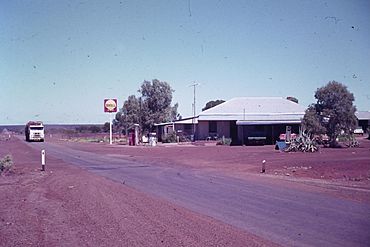Paynes Find, Western Australia facts for kids
Quick facts for kids Paynes FindWestern Australia |
|||||||||
|---|---|---|---|---|---|---|---|---|---|

Paynes Find around 1980
|
|||||||||

Paynes Find in September 2023
|
|||||||||
| Established | 1911 | ||||||||
| Postcode(s) | 6612 | ||||||||
| Elevation | 339 m (1,112 ft) | ||||||||
| Area | [convert: needs a number] | ||||||||
| Location |
|
||||||||
| LGA(s) | Shire of Yalgoo | ||||||||
| State electorate(s) | North West | ||||||||
| Federal Division(s) | Durack | ||||||||
|
|||||||||
Paynes Find, sometimes called Paynes, is a small settlement in Western Australia. It's about 430 kilometers (267 miles) northeast of Perth. You can get there by driving on the Great Northern Highway. This place was first started because someone found gold!
Today, Paynes Find has a roadhouse (a place to get fuel and food), a special machine called a gold battery, and a few other buildings. Besides its history with gold, the area is also known for its beautiful yearly bloom of everlasting wildflowers. There are also many sheep stations (large farms) nearby.
Contents
History of Paynes Find
How Paynes Find Began
The town of Paynes Find officially became a town in 1911. This was the same year that a gold battery was built there. A gold battery is a big machine that crushes rocks to get the gold out. This battery is still working today, and it's the only one like it left in Western Australia!
The town is named after a prospector (a person who searches for valuable minerals) named Thomas Payne. He was the first person to discover gold in this area. Thomas Payne was also the first to officially claim land for gold mining with the government.
Thomas Payne's Reward
Because he found the gold, Thomas Payne received a special reward. He was allowed to use the state's gold battery for free! His gold ore (rock containing gold) was the very first to be crushed by the new battery. Another old town, Paynesville, was also named in his honor.
Challenges and Growth
Getting enough water was always a big problem for mining in Paynes Find. Water was needed for people to drink and for the gold battery to work. Even with this challenge, the town grew. By the 1930s, Paynes Find was doing very well. It had an estimated population of about 500 people.
In 1987, the gold battery was sold to the Taylor family. They still own it today and use it as a place for tourists to visit and learn about gold mining.
Images for kids



